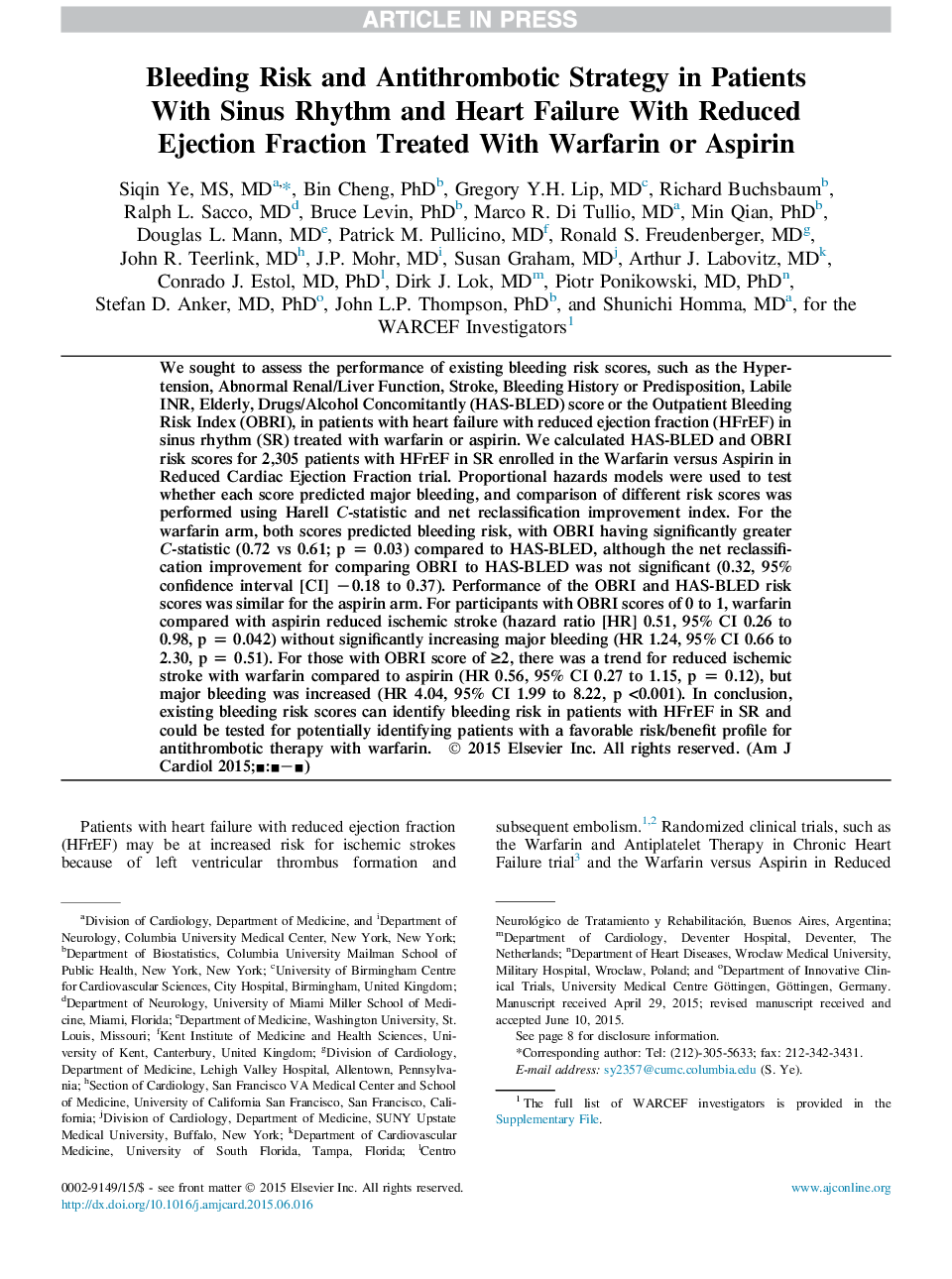| کد مقاله | کد نشریه | سال انتشار | مقاله انگلیسی | نسخه تمام متن |
|---|---|---|---|---|
| 5929784 | 1572130 | 2015 | 9 صفحه PDF | دانلود رایگان |
عنوان انگلیسی مقاله ISI
Bleeding Risk and Antithrombotic Strategy in Patients With Sinus Rhythm and Heart Failure With Reduced Ejection Fraction Treated With Warfarin or Aspirin
ترجمه فارسی عنوان
ریسک خونریزی و استراتژی آنتی ترومبوتیک در بیماران مبتلا به ریتم سینوسی و نارسایی قلب با کاهش فراوانی تخریب شده با وارفارین یا آسپیرین
دانلود مقاله + سفارش ترجمه
دانلود مقاله ISI انگلیسی
رایگان برای ایرانیان
موضوعات مرتبط
علوم پزشکی و سلامت
پزشکی و دندانپزشکی
کاردیولوژی و پزشکی قلب و عروق
چکیده انگلیسی
We sought to assess the performance of existing bleeding risk scores, such as the Hypertension, Abnormal Renal/Liver Function, Stroke, Bleeding History or Predisposition, Labile INR, Elderly, Drugs/Alcohol Concomitantly (HAS-BLED) score or the Outpatient Bleeding Risk Index (OBRI), in patients with heart failure with reduced ejection fraction (HFrEF) in sinus rhythm (SR) treated with warfarin or aspirin. We calculated HAS-BLED and OBRI risk scores for 2,305 patients with HFrEF in SR enrolled in the Warfarin versus Aspirin in Reduced Cardiac Ejection Fraction trial. Proportional hazards models were used to test whether each score predicted major bleeding, and comparison of different risk scores was performed using Harell C-statistic and net reclassification improvement index. For the warfarin arm, both scores predicted bleeding risk, with OBRI having significantly greater C-statistic (0.72 vs 0.61; p = 0.03) compared to HAS-BLED, although the net reclassification improvement for comparing OBRI to HAS-BLED was not significant (0.32, 95% confidence interval [CI] â0.18 to 0.37). Performance of the OBRI and HAS-BLED risk scores was similar for the aspirin arm. For participants with OBRI scores of 0 to 1, warfarin compared with aspirin reduced ischemic stroke (hazard ratio [HR] 0.51, 95% CI 0.26 to 0.98, p = 0.042) without significantly increasing major bleeding (HR 1.24, 95% CI 0.66 to 2.30, p = 0.51). For those with OBRI score of â¥2, there was a trend for reduced ischemic stroke with warfarin compared to aspirin (HR 0.56, 95% CI 0.27 to 1.15, p = 0.12), but major bleeding was increased (HR 4.04, 95% CI 1.99 to 8.22, p <0.001). In conclusion, existing bleeding risk scores can identify bleeding risk in patients with HFrEF in SR and could be tested for potentially identifying patients with a favorable risk/benefit profile for antithrombotic therapy with warfarin.
ناشر
Database: Elsevier - ScienceDirect (ساینس دایرکت)
Journal: The American Journal of Cardiology - Volume 116, Issue 6, 15 September 2015, Pages 904-912
Journal: The American Journal of Cardiology - Volume 116, Issue 6, 15 September 2015, Pages 904-912
نویسندگان
Siqin MS, MD, Bin PhD, Gregory Y.H. MD, Richard Buchsbaum, Ralph L. MD, Bruce PhD, Marco R. MD, Min PhD, Douglas L. MD, Patrick M. MD, Ronald S. MD, John R. MD, J.P. MD, Susan MD, Arthur J. MD, Conrado J. MD, PhD, Dirk J. MD, Piotr MD, PhD, Shunichi MD,
